ANGLES AND PARALLEL LINES
Subscribe to our ▶️ YouTube channel 🔴 for the latest videos, updates, and tips.
Objectives :
• Understand the parallel lines cut by a transversal theorem and it’s converse.
• Find angle measures using the Theorem.
• Use algebra to find unknown variable and angle measures involve parallel lines and transversals.
• Use Auxiliary lines to find unknown angle measures.
When two parallel lines are cut by a transversal, the following pairs of angles are congruent.
• corresponding angles
• alternate interior angles
• alternate exterior angles
• consecutive interior angles are supplementary
Example 1 :
In the figure shown below, m∠2 = 75°. Find the measures of the remaining angles.
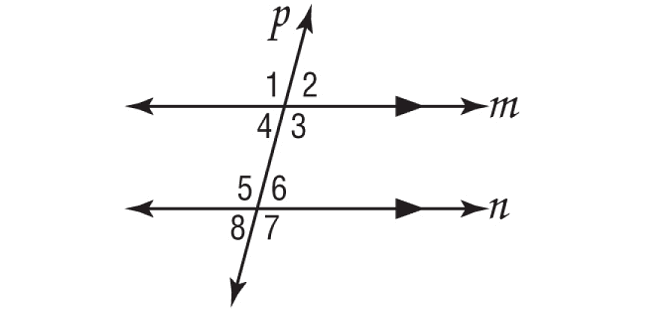
Solution :
∠1 and ∠2 form a linear pair and they are supplementary.
m∠1 + m∠2 = 180°
m∠1 + 75° = 180°
m∠1 = 105°
∠1 and ∠3 are vertical angles and they are equal.
m∠3 = m∠1
m∠3 = 105°
∠2 and ∠4 are vertical angles and they are equal.
m∠4 = m∠2
m∠4 = 75°
∠1 and ∠5 are corresponding angles and they are equal.
m∠5 = m∠1
m∠5 = 105°
∠2 and ∠6 are corresponding angles and they are equal.
m∠6 = m∠2
m∠6 = 75°
∠4 and ∠8 are corresponding angles and they are equal.
m∠8 = m∠4
m∠8 = 75°
∠3 and ∠7 are corresponding angles and they are equal.
m∠7 = m∠3
m∠7 = 105°
Example 2 :
In the figure shown below, m∠3 = 102°. Find the measure of each angle. Tell which postulate(s) or theorem(s) you used.
a. ∠5 b. ∠6 c. ∠11 d. ∠7 e. ∠15 f. ∠14
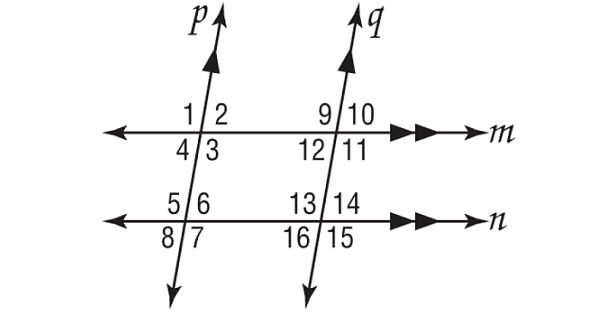
Solution :
(a) :
m∠5 = m∠3
m∠5 = 102°
(Alternate Interior Angles Theorem)
(b) :
m∠3 + m∠6 = 180°
102° + m∠6 = 180°
m∠6 = 78°
(Interior Angles on the Same Side of the Transversal Theorem)
(c) :
m∠11 = m∠3
m∠11 = 102°
(Corresponding Angles Postulate)
(d) :
m∠7 = m∠3
m∠7 = 102°
(Corresponding Angles Postulate)
(e) :
m∠15 = m∠7
m∠15 = 102°
(Corresponding Angles Postulate)
(f) :
m∠14 = m∠6
m∠14 = 78°
(Corresponding Angles Postulate)
Example 3 :
In the figure shown below, m∠5 = 68° and m∠9 = 80°. Find the measure of each angle. Tell which postulate(s) or theorem(s) you used.
a. ∠12 b. ∠1 c. ∠4 d. ∠3 e. ∠7 f. ∠16
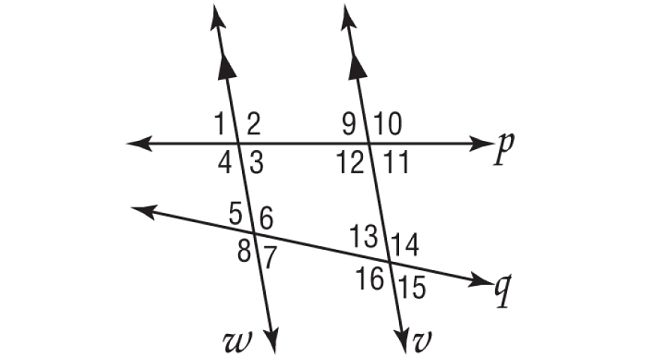
Solution :
(a) :
m∠9 + m∠12 = 180°
80° + m∠12 = 180°
m∠12 = 100°
(Linear Pair Postulate)
(b) :
m∠1 = m∠9
m∠1 = 80°
(Corresponding Angles Postulate)
(c) :
m∠4 = m∠12
m∠4 = 100°
(Corresponding Angles Postulate)
(d) :
m∠3 = m∠9
m∠3 = 80°
(Alternate Interior Angles Theorem)
(e) :
m∠7 = m∠5
m∠7 = 68°
(Vertical Angles Theorem)
(f) :
m∠7 + m∠16 = 180°
68° + m∠16 = 180°
m∠16 = 112°
(Interior Angles on the Same Side of the Transversal Theorem)
Algebra and Angle Measures
Algebra can be used to find unknown values in angles formed by a transversal and parallel lines.
Example 4 :
If m∠1 = 3x + 15, m∠2 = 4x - 5, and m∠3 = 5y, find the value of x and y.
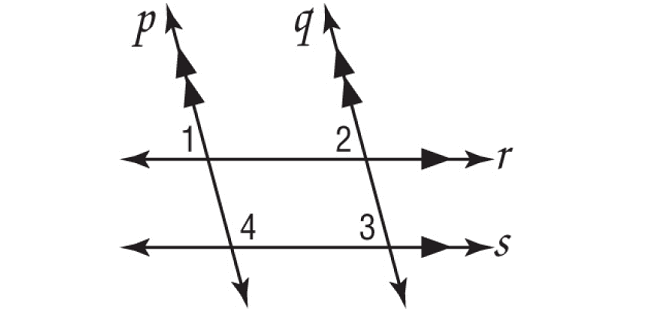
Solution :
∠1 and ∠2 are corresponding angles and they are equal.
m∠1 = m∠2
3x + 15 = 4x - 5
Subtract 3x from each side.
15 = x - 5
Add 5 to each side.
20 = x
∠2 and ∠3 are corresponding angles and they are equal.
m∠2 = m∠3
4x - 5 = 5y
Substitute x = 20.
4(20) - 5 = 5y
80 - 5 = 5y
75 = 5y
Divide each side by 5.
15 = y
Therefore,
x = 20 and y = 15
Using Auxiliary Lines
Example 5 :
Using a 3rd parallel Line – Auxiliary Line, find the value of x.
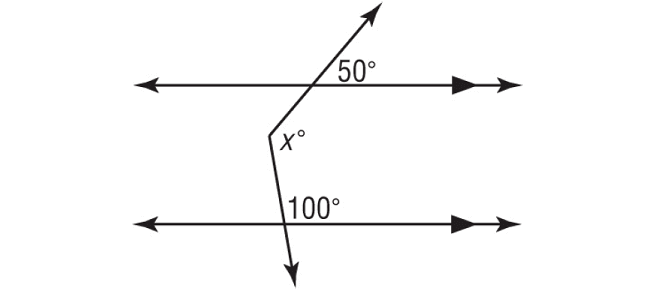
Solution :
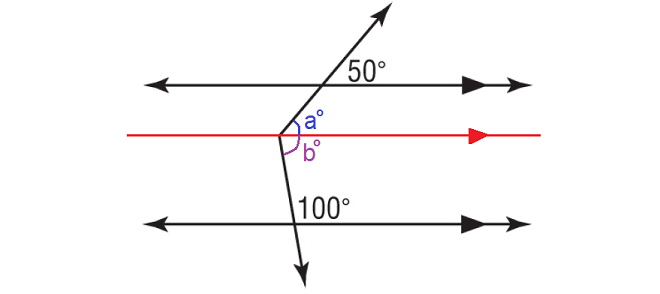
In the figure above, a° and 50° are corresponding angles and they are equal.
a° = 50°
b° and 100° are interior angles on the same side of the transversal and they are supplementary.
b° + 100° = 180°
Subtract 100° from each side.
b° = 80°
In the figure above,
x = a + b
= 50 + 80
= 130
Subscribe to our ▶️ YouTube channel 🔴 for the latest videos, updates, and tips.
Kindly mail your feedback to v4formath@gmail.com
We always appreciate your feedback.
About Us | Contact Us | Privacy Policy
©All rights reserved. onlinemath4all.com

Recent Articles
-
US Common Core K-12 Curricum Algebra Solving Simple Equations
Jan 07, 26 01:53 PM
US Common Core K-12 Curricum Algebra Solving Simple Equations -
10 Hard SAT Math Questions (Part - 4)
Jan 05, 26 06:56 PM
10 Hard SAT Math Questions (Part - 4) -
10 Hard SAT Math Questions (Part - 3)
Jan 05, 26 06:34 PM
10 Hard SAT Math Questions (Part - 3)

